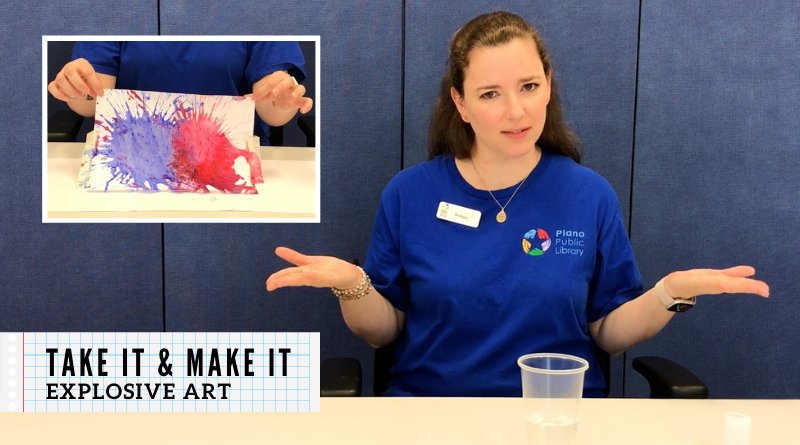
STEAM Connections: Explosive Art
Have you been driving or riding in a car recently? Have you cooked or eaten food today? These are all examples of chemical reactions. Do you know what else is a chemical reaction? Explosions!
Content Overview
Explosions are the result of chemical reactions. Chemical reactions happen all around us each day. When you eat, your body creates a chemical reaction to break down the food into energy. But what if you get an upset stomach? You might take a sodium bicarbonate effervescent tab, like Alka Seltzer.
Putting a sodium bicarbonate effervescent tab in water causes a chemical reaction. This is because the tabs have citric acid and a baking soda base. Acids are molecules that can donate small charged particles called hydrogen ions. Bases are the opposite – they accept hydrogen ions. When acids and bases combine, they create a chemical reaction. But why does a sodium bicarbonate tab only create a chemical reaction in water?
There are three states of matter: solid, liquid and gas. Atoms and molecules don’t really move in solids. They move more in liquids, and they really move in gases. Because the sodium bicarbonate tab is a solid, the molecules don’t move around as much. Once they dissolve in water, the molecules start moving and interacting with each other, causing a chemical reaction and producing carbon dioxide gas. That’s why you see those fizzy air bubbles.
Hands-On Exploration
All of that air needs to go somewhere. When you put a sodium bicarbonate tab and water in a container, that container will have an increase in pressure. In our experiment, we’ll use a film canister that will appear to explode due to the increase in air pressure.
Activity Demonstration and Supplies

You will need:
- Film canister
- Sodium bicarbonate effervescent tab
- Measuring spoons
- Water
- Paint (tempera paint works best)
- Paper
- Tape (optional)
Instructions:
This experiment is best done outside. Film canisters may fly up to 20 feet in the air.
- Put your paper on the ground. You may tape it in place to keep it secure.
- Open the film canister and squirt a little bit of paint in it. You need enough to cover the bottom.
- Using a measuring spoon, measure how much water you’re adding. The amount of water may vary based on how much paint you add.
- Close the canister and shake it to thoroughly mix the water and paint together.
- Open the canister and carefully add the sodium bicarbonate effervescent tab.
- Close the canister.
- Place the canister lid down on the paper.
- Wait for the explosion. Depending on the amount of water added, it may take up to five minutes. If no explosion happens after five minutes, carefully open the canister (pointing it away from your face) and begin again.
- Repeat steps 2-8 as desired.
Talk About the Activity

- How fast did your canister explode? Was it fast? Was it slow?
- What could you do to speed up the chemical reaction? What could you do to slow it down?
- How much water did you need for the perfect explosion? How does that compare to how much paint you added?
Continued Learning
Chemical reactions are all around us. By combining acids and bases, we an create chemical reactions that produce lots of gases. In this experiment, we used sodium bicarbonate effervescent tabs that contain both acid and base in solid form. Those reacted when we dissolved the tab in paint mixed with water. Can you think of other ways to make chemical reactions? Try them out!
Check It Out
Learn more about chemical reactions with resources from the library:

Why Is Milk White? by Alexa Coelho
Ace Your Science Project Using Chemistry Magic and Toys by Robert Gardner
Outdoor Science Lab for Kids by Liz Lee Heinecke
Oh, Ick! by Joy Masoff and Jessica Garrett
Building Molecules Chemistry STEAM Kit




